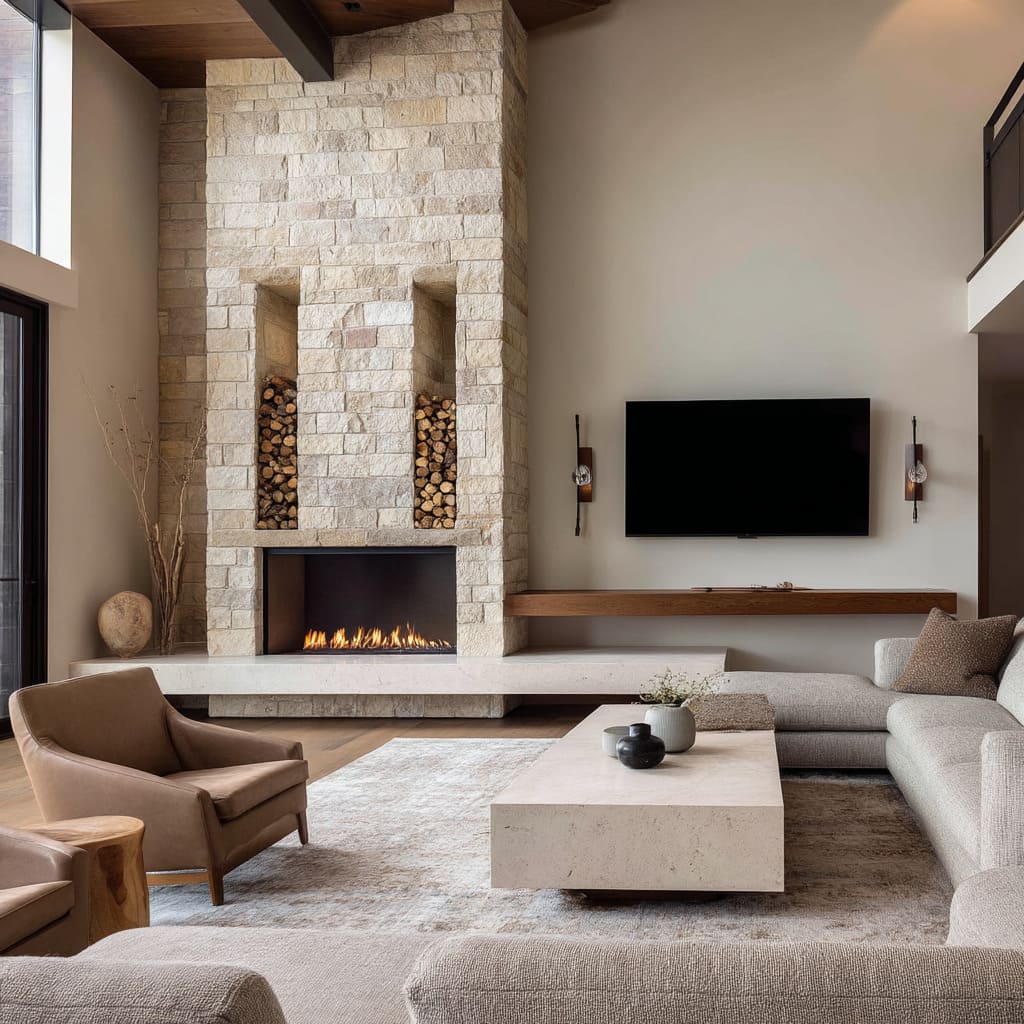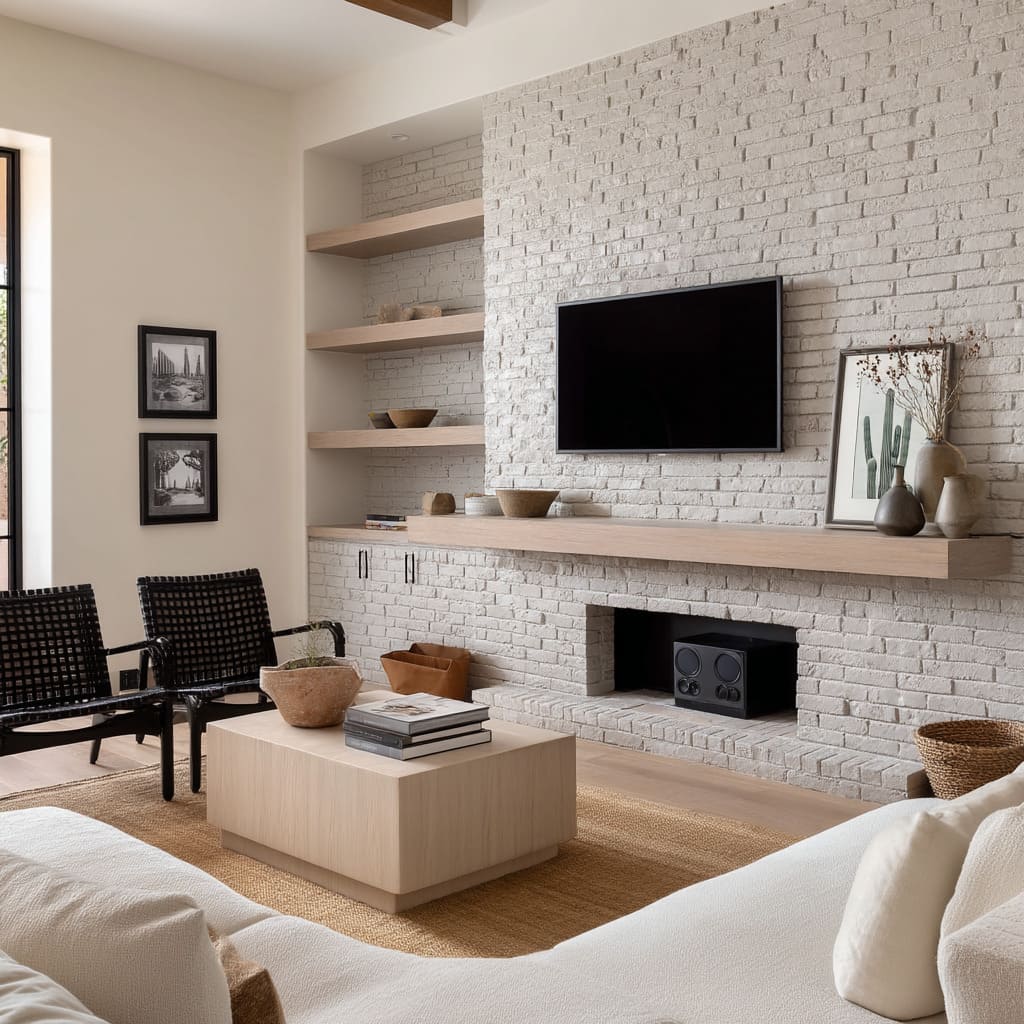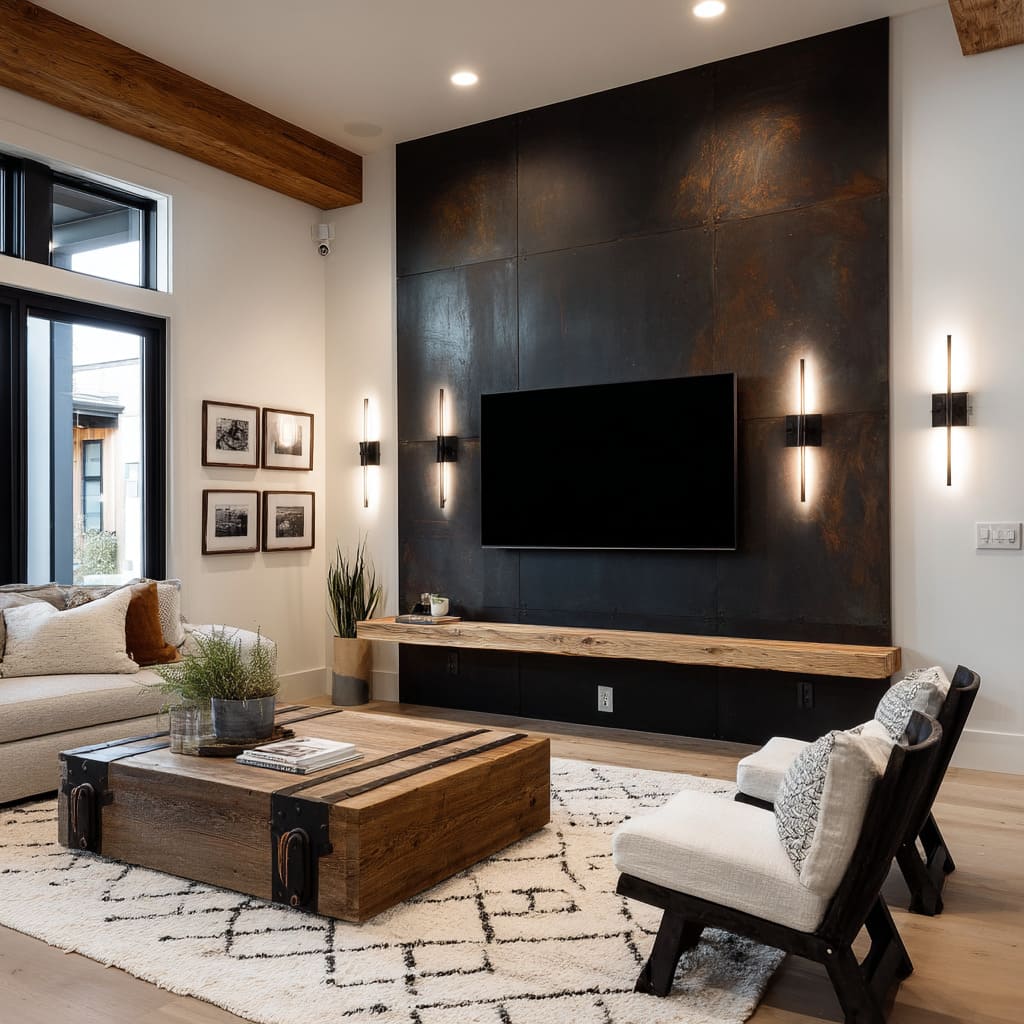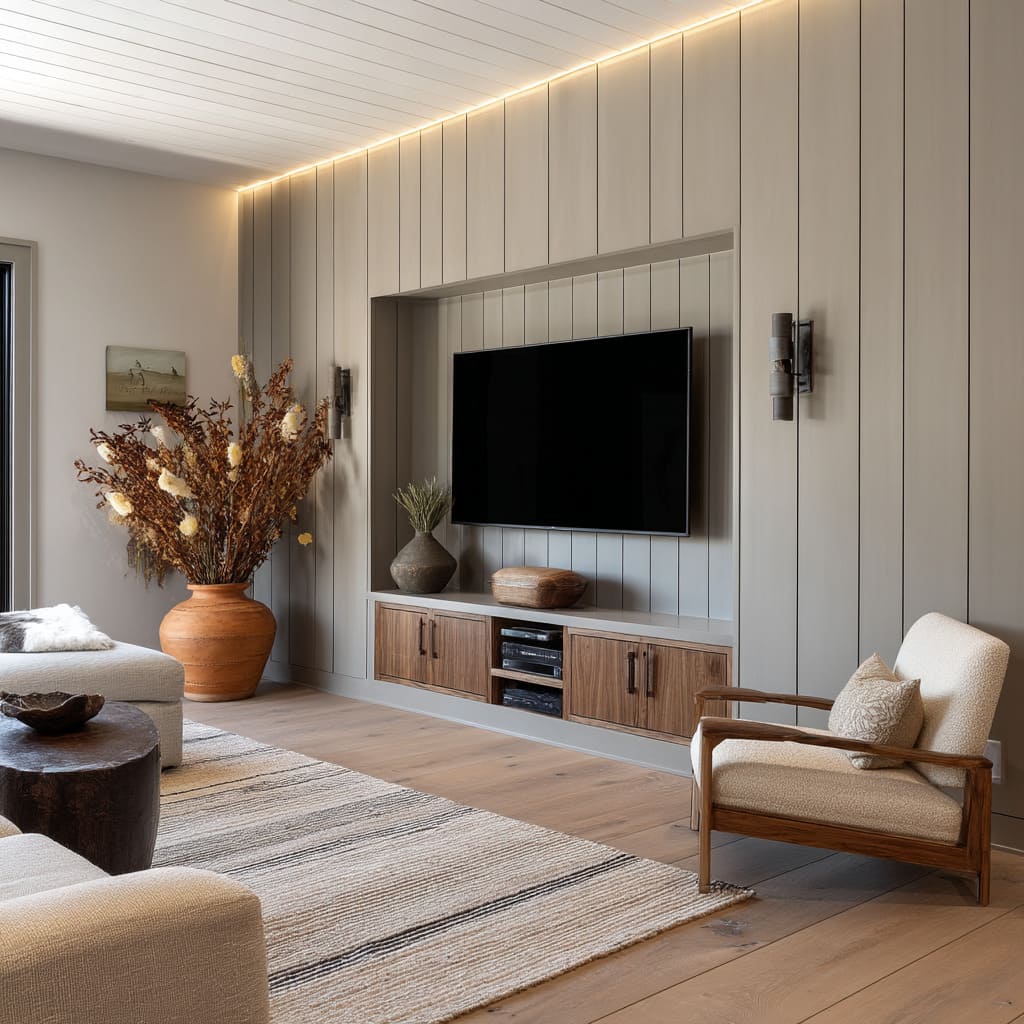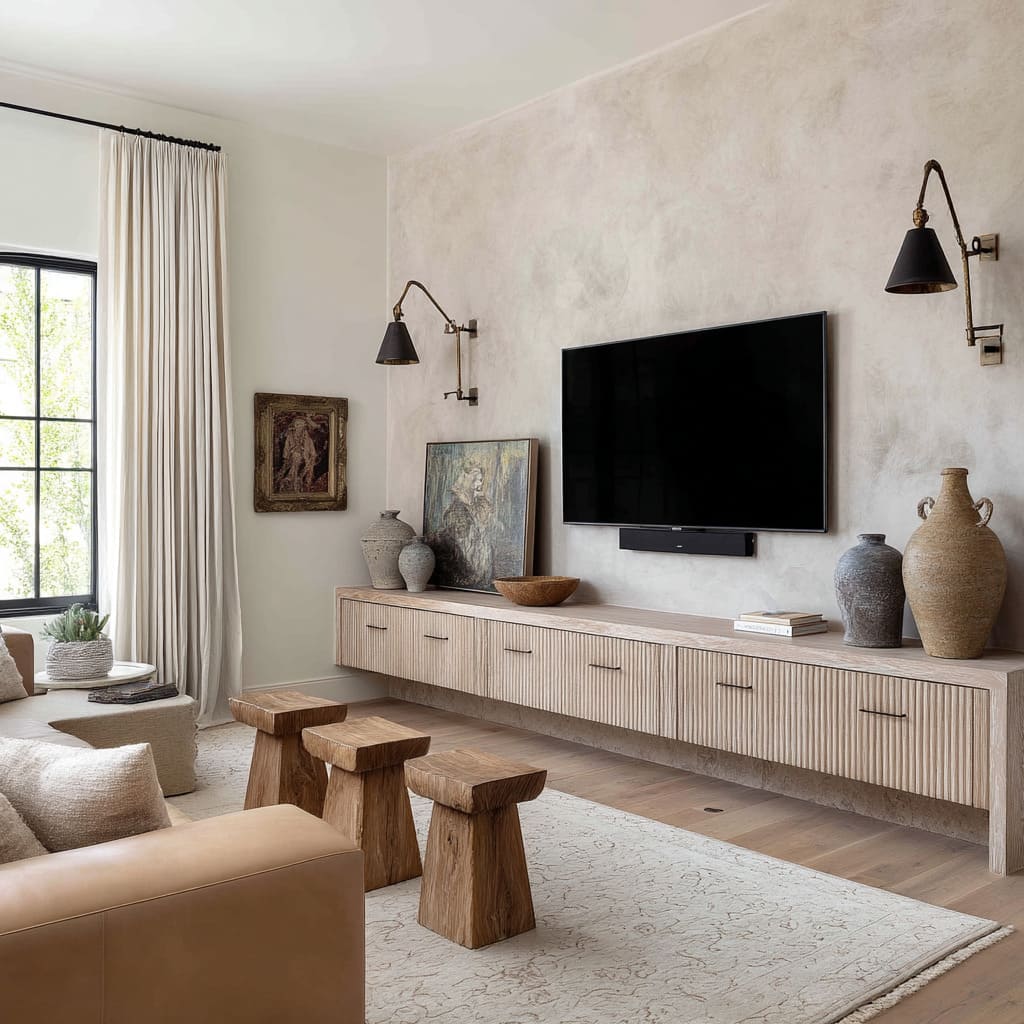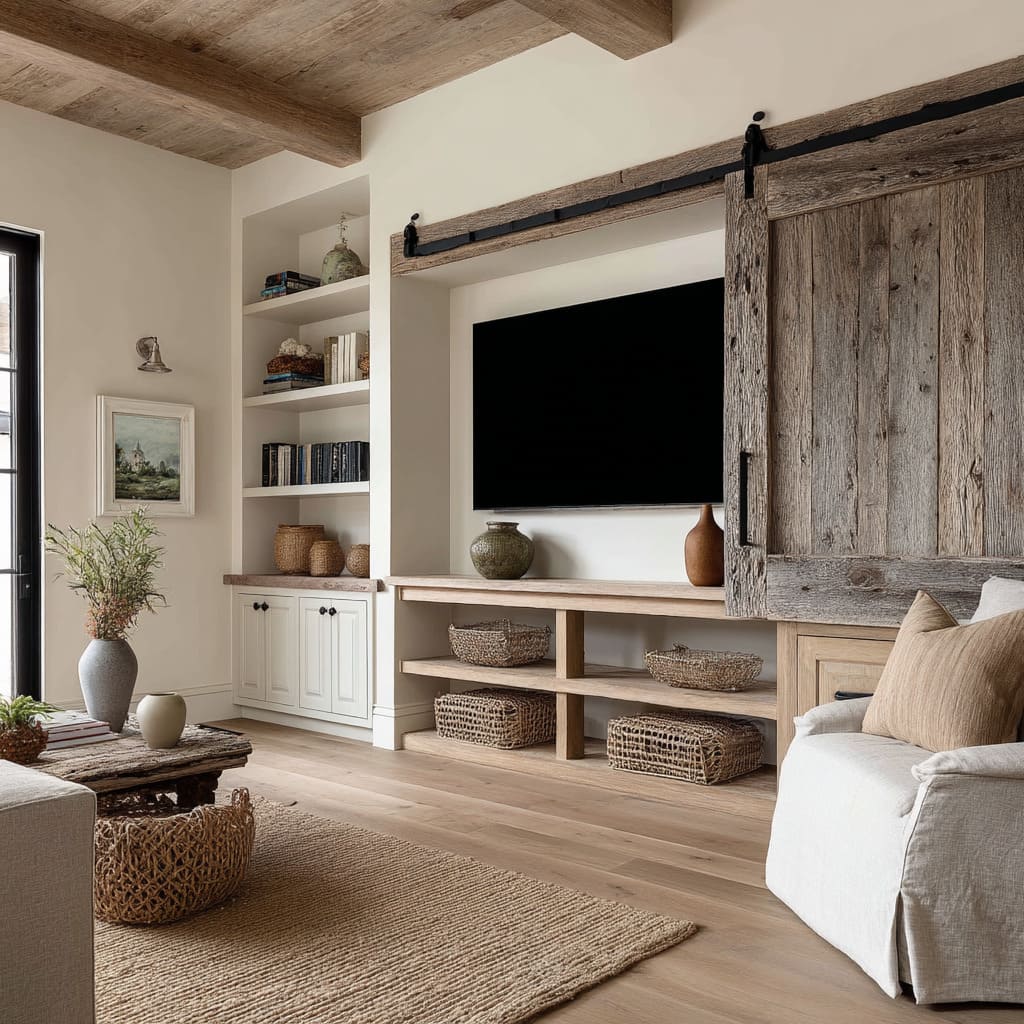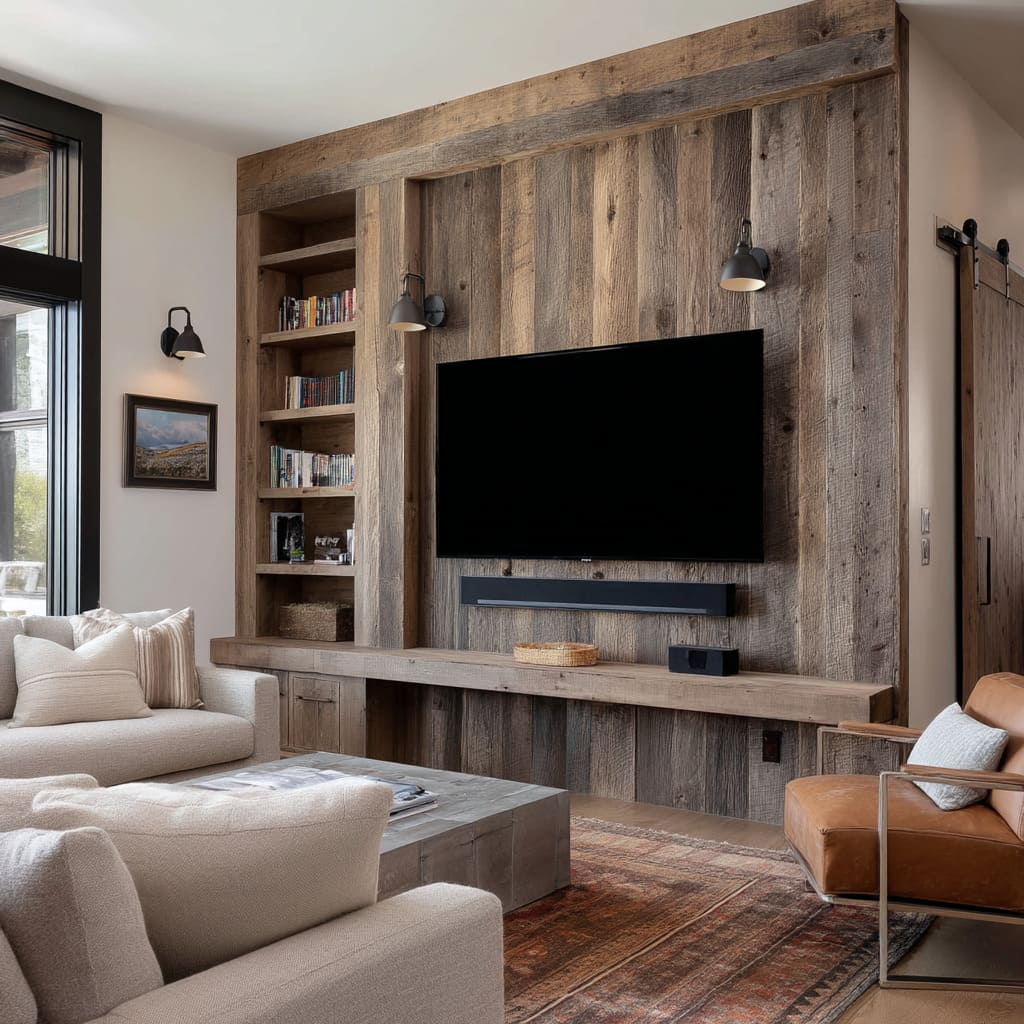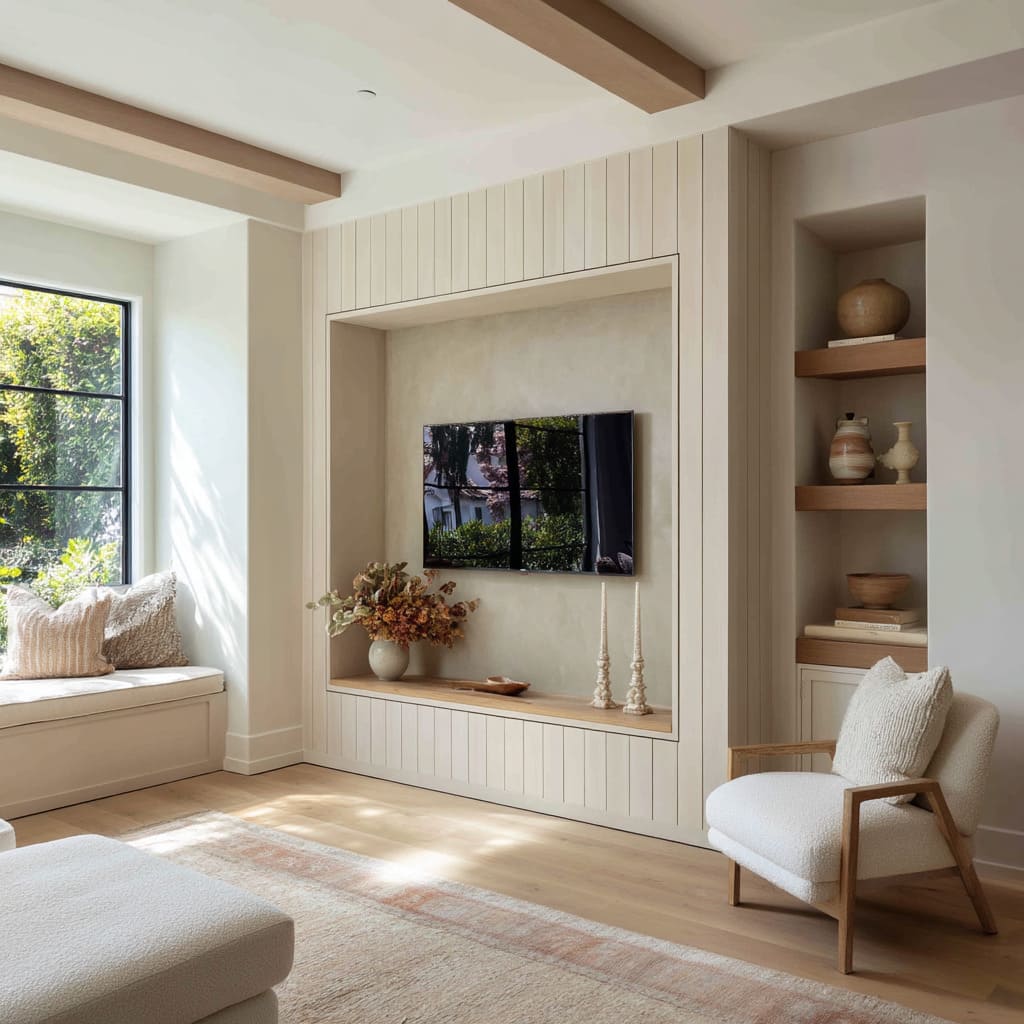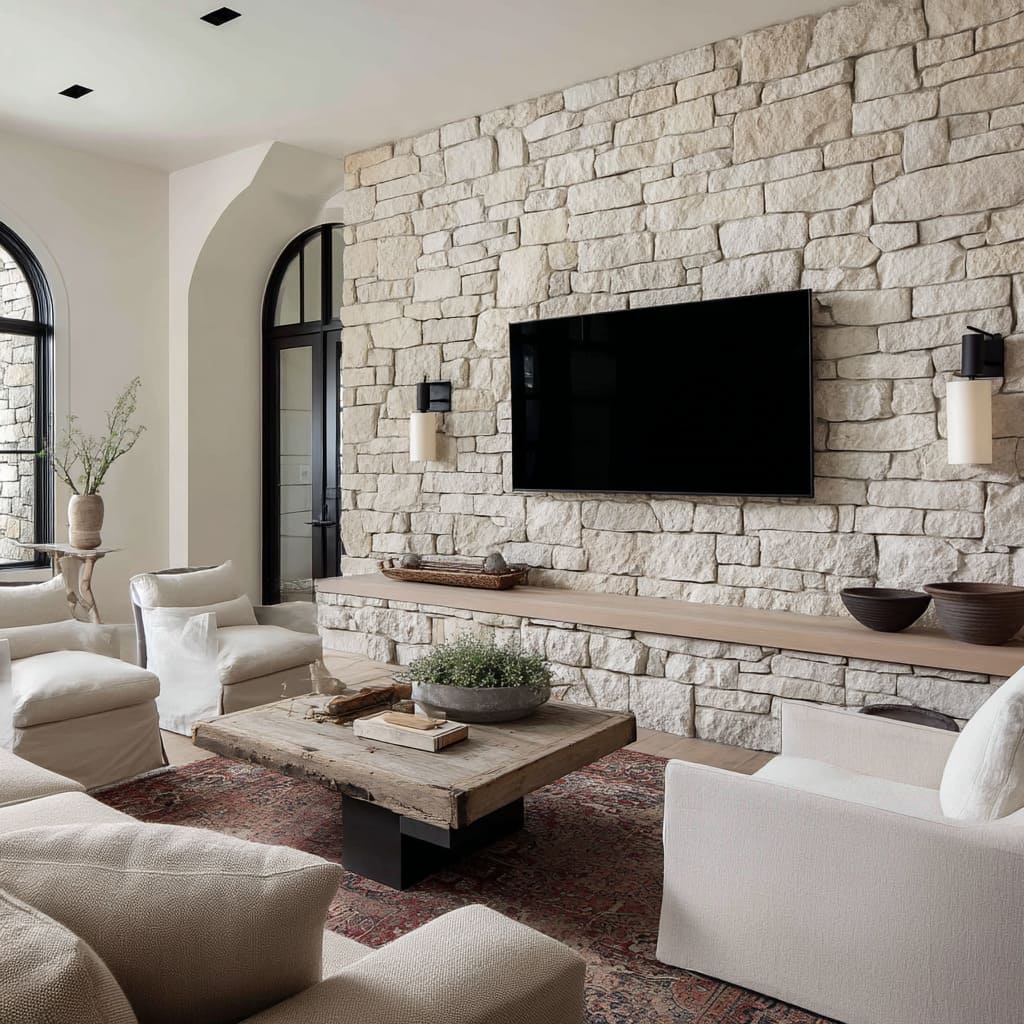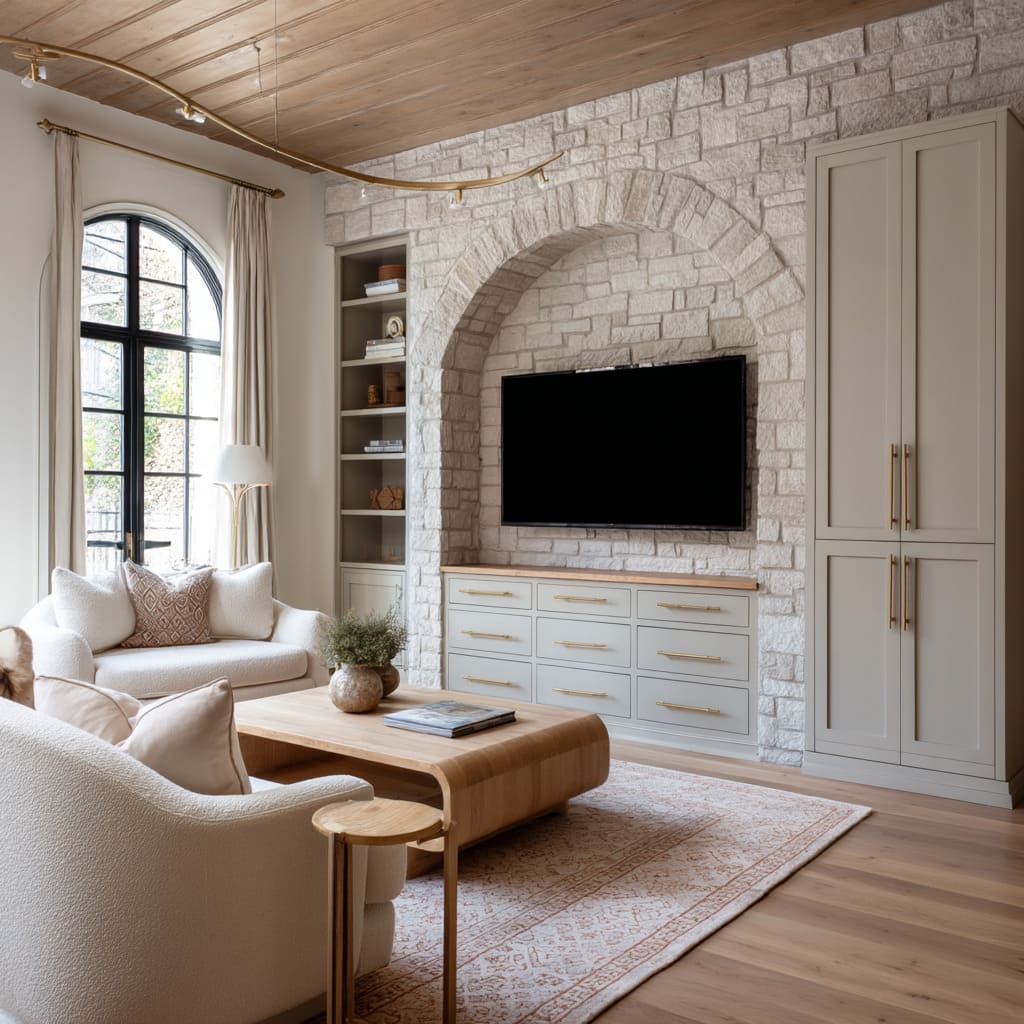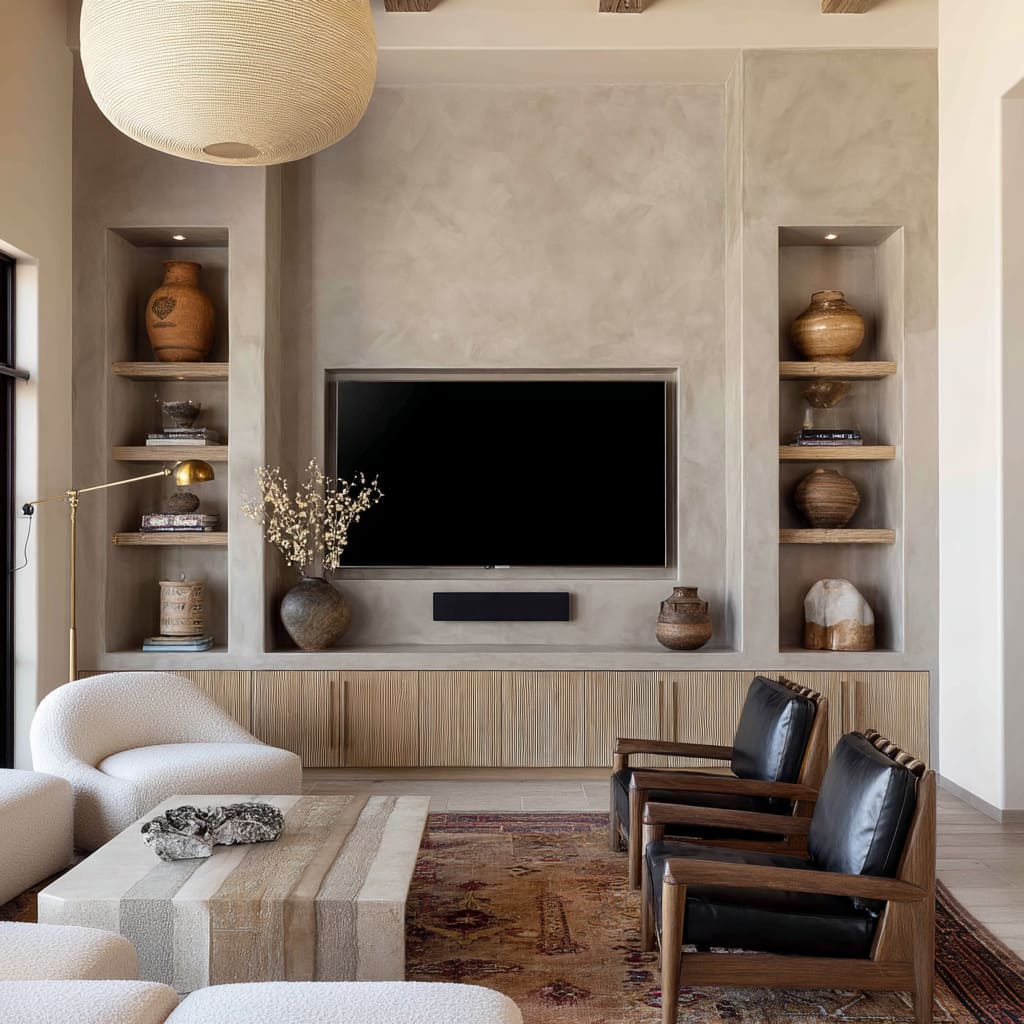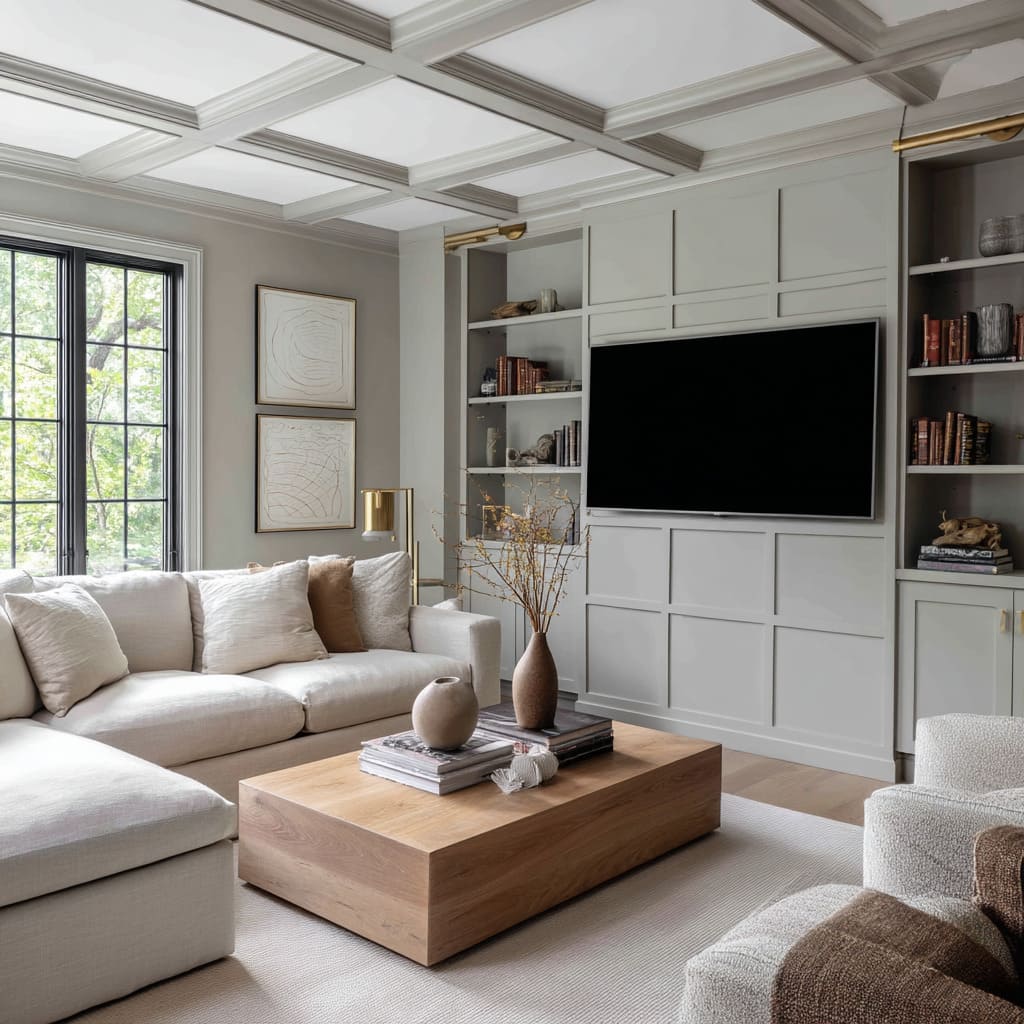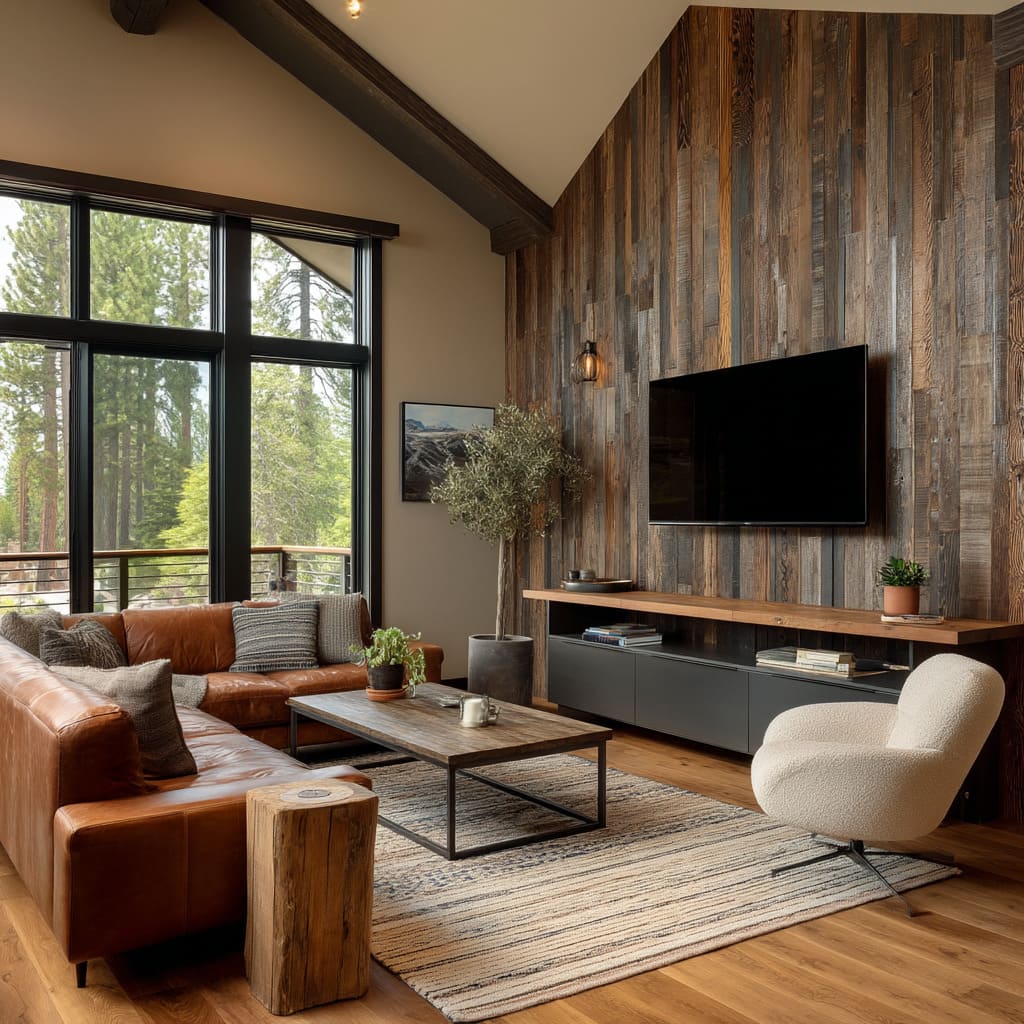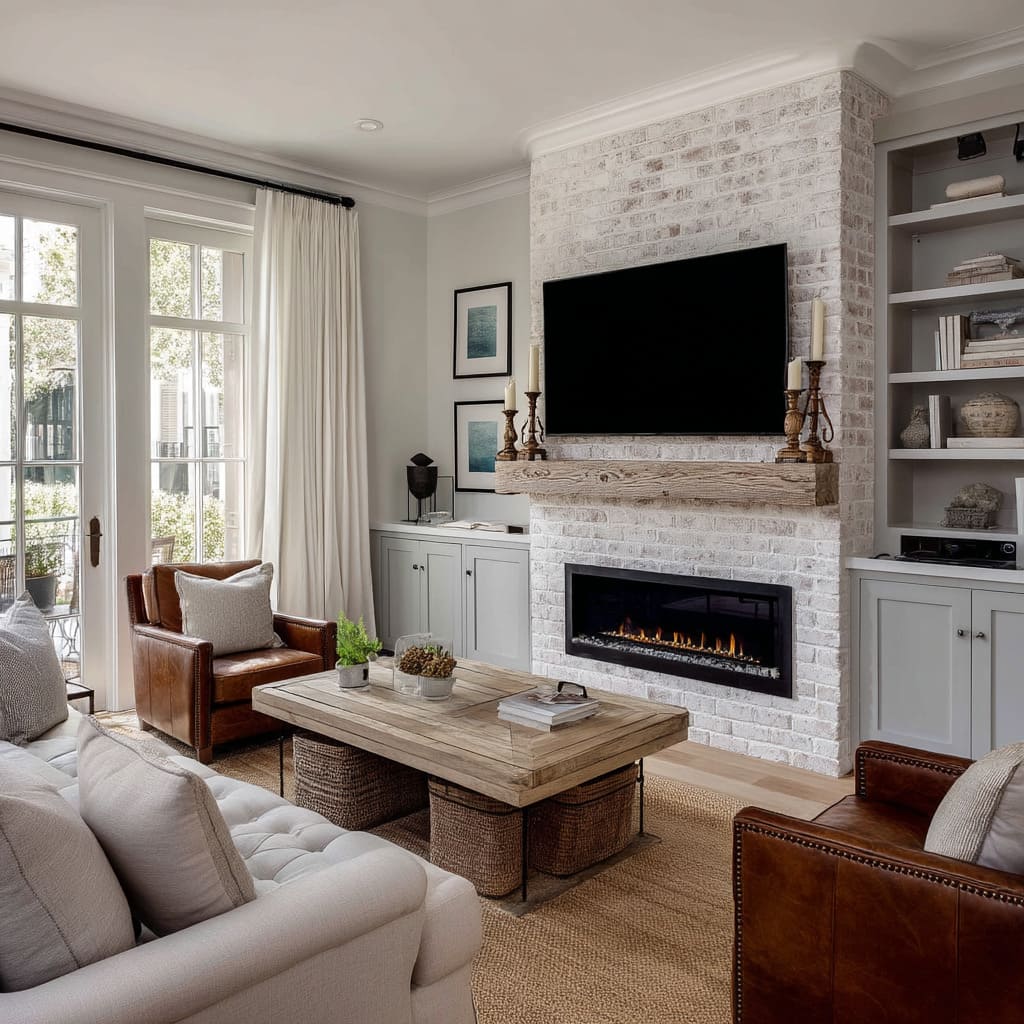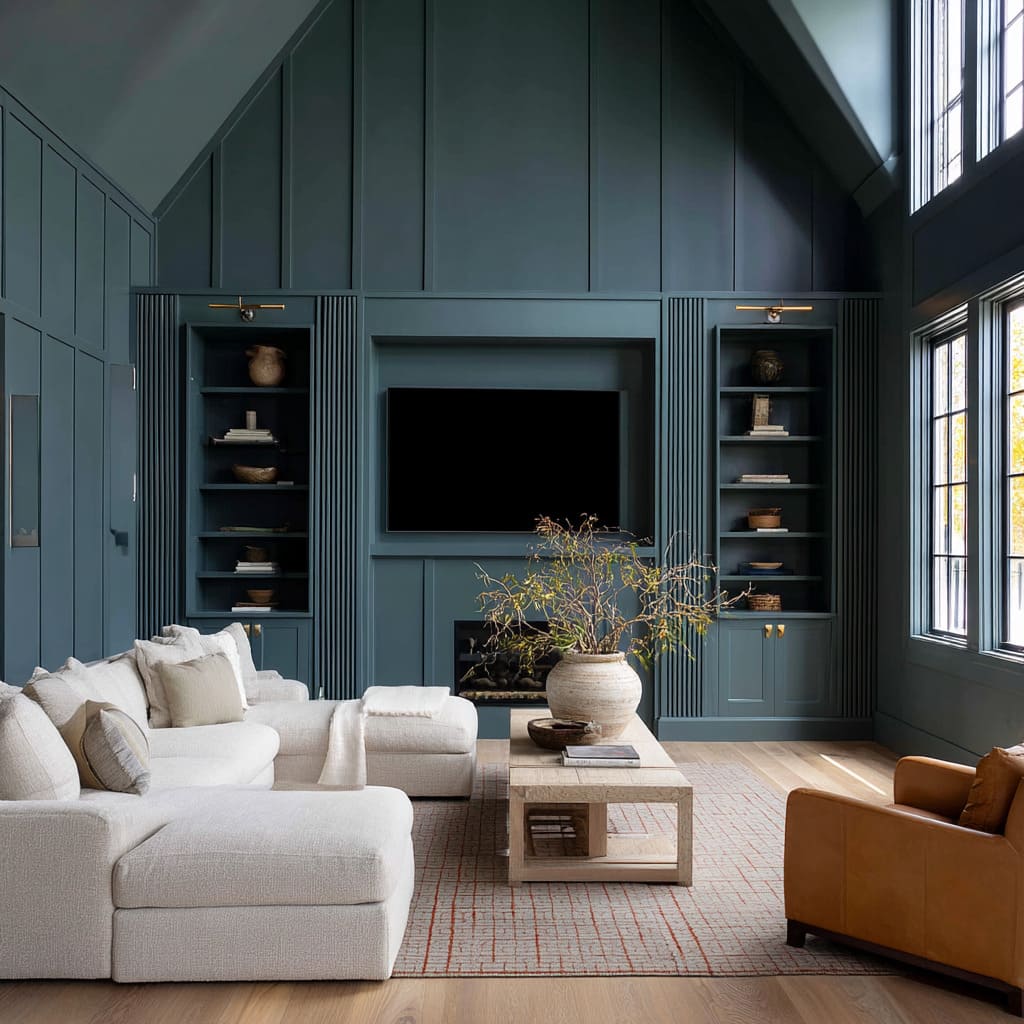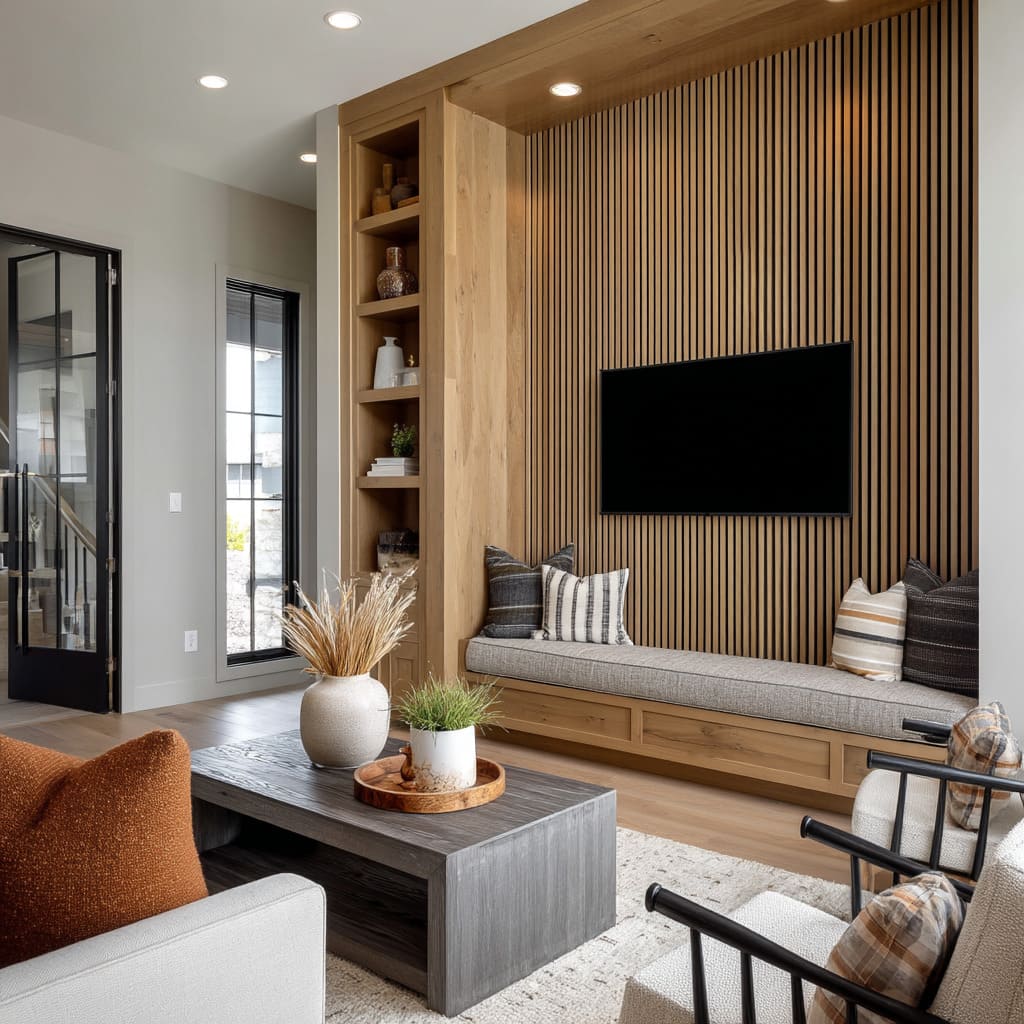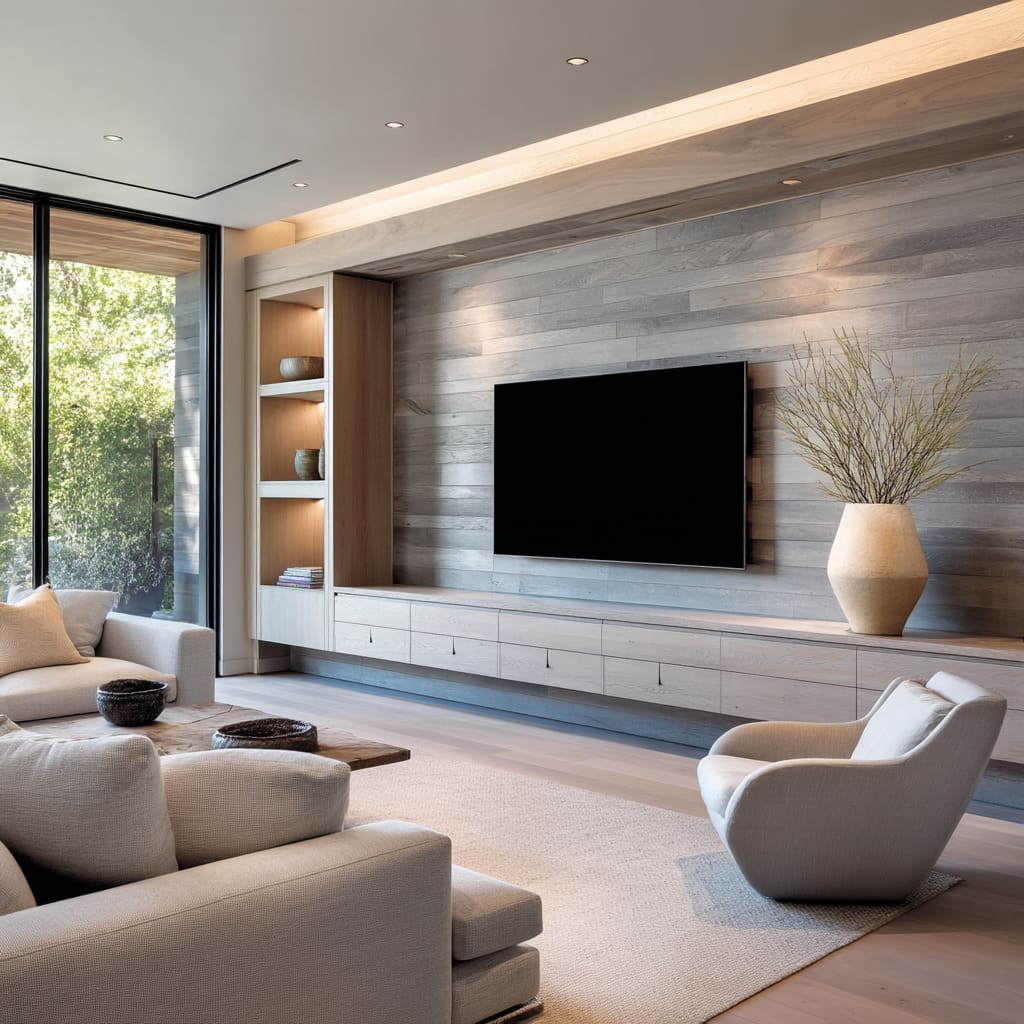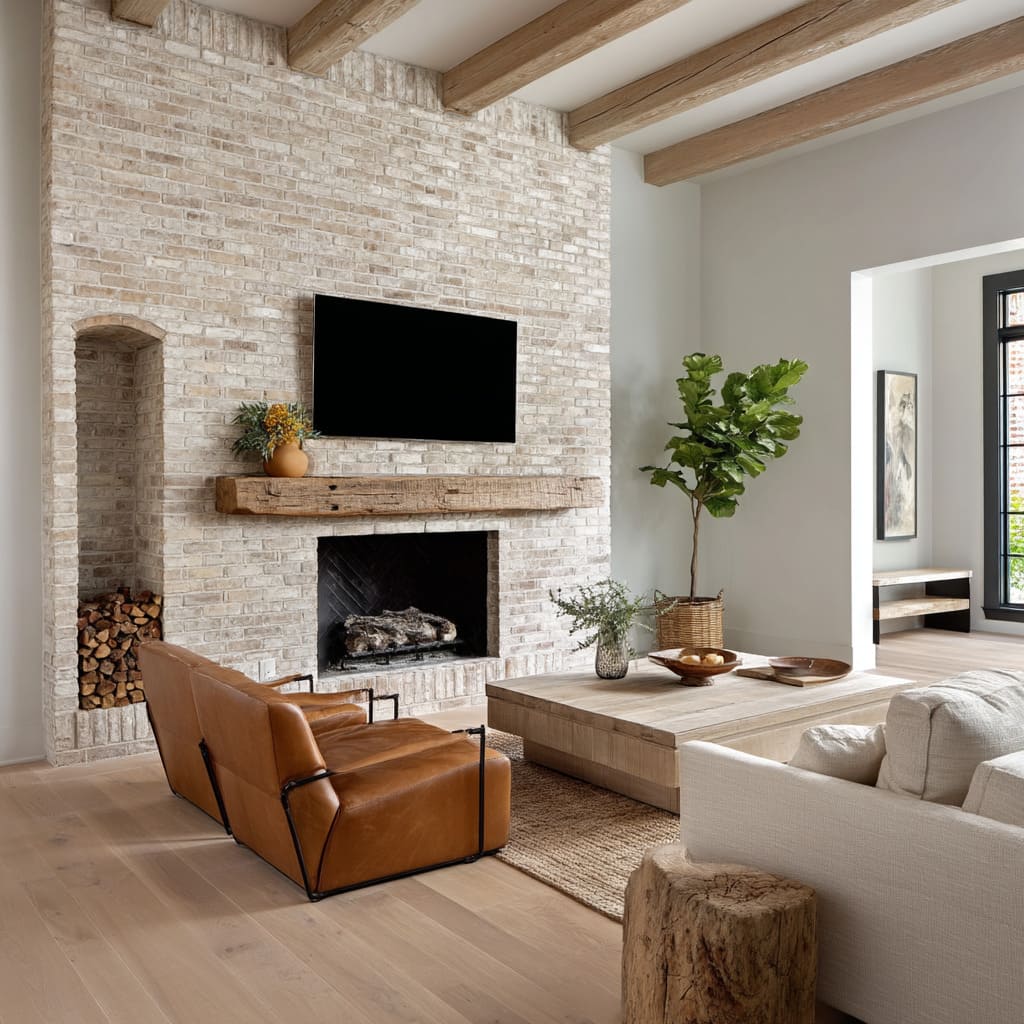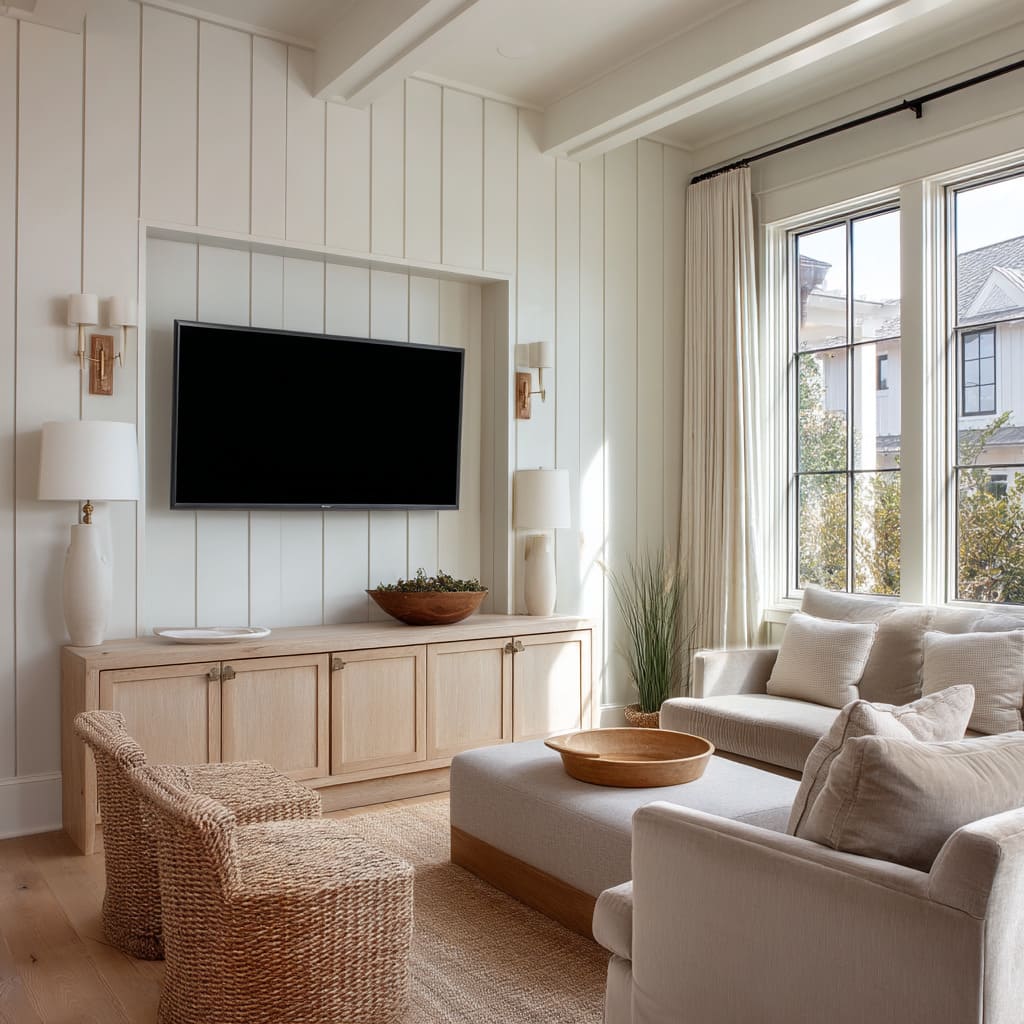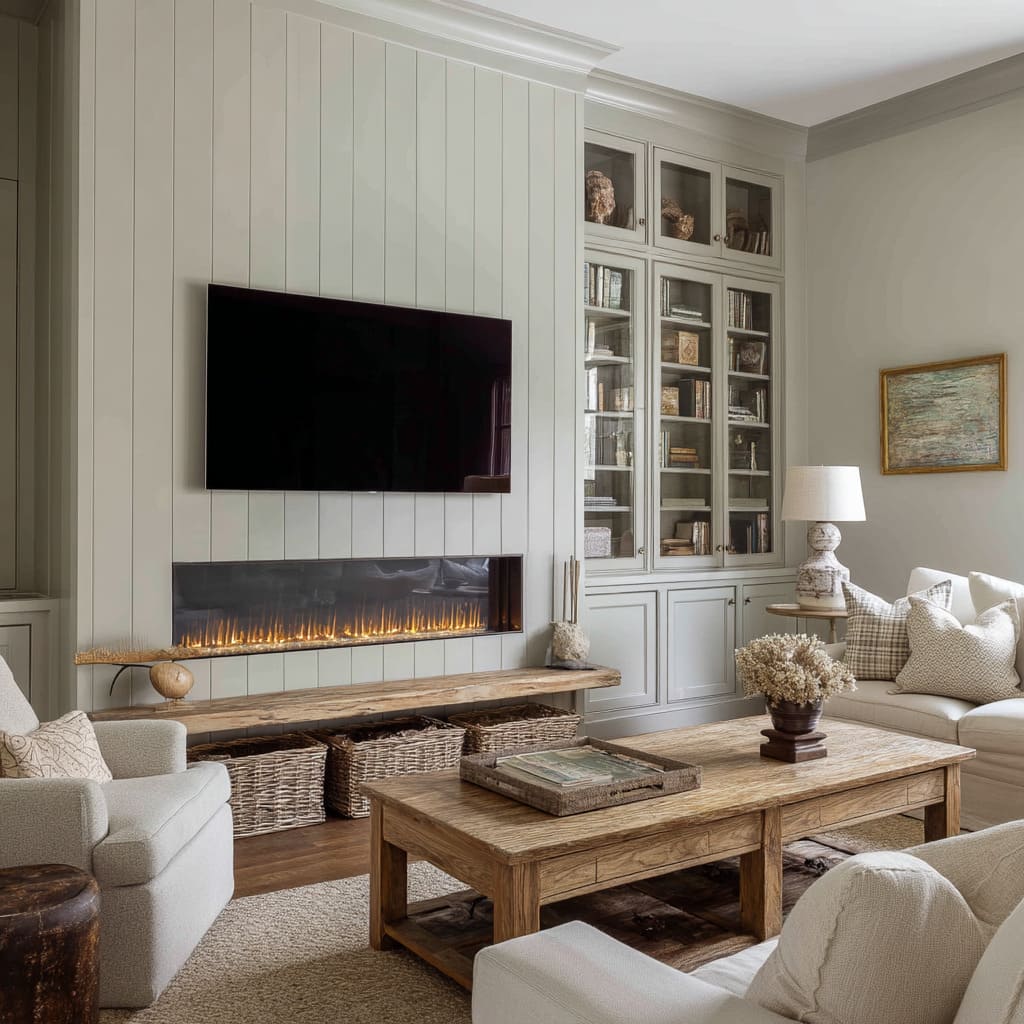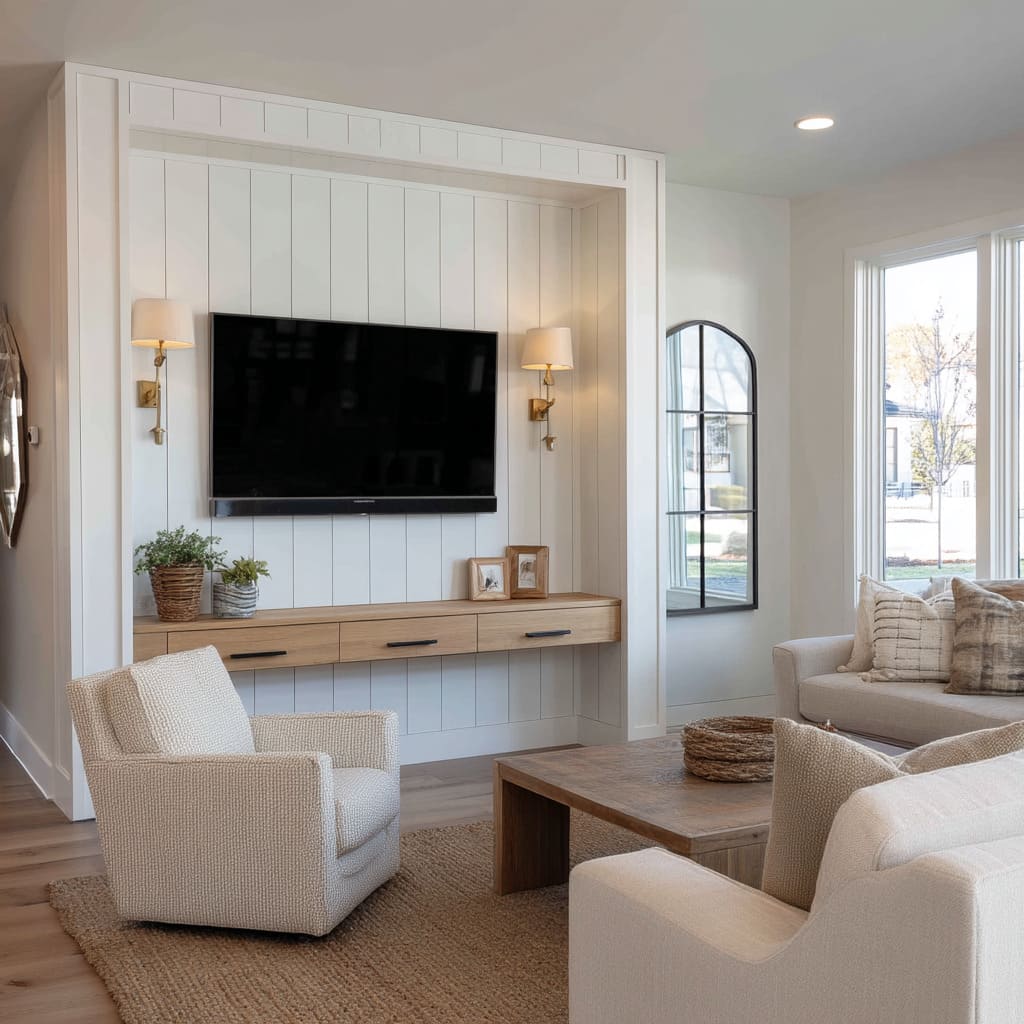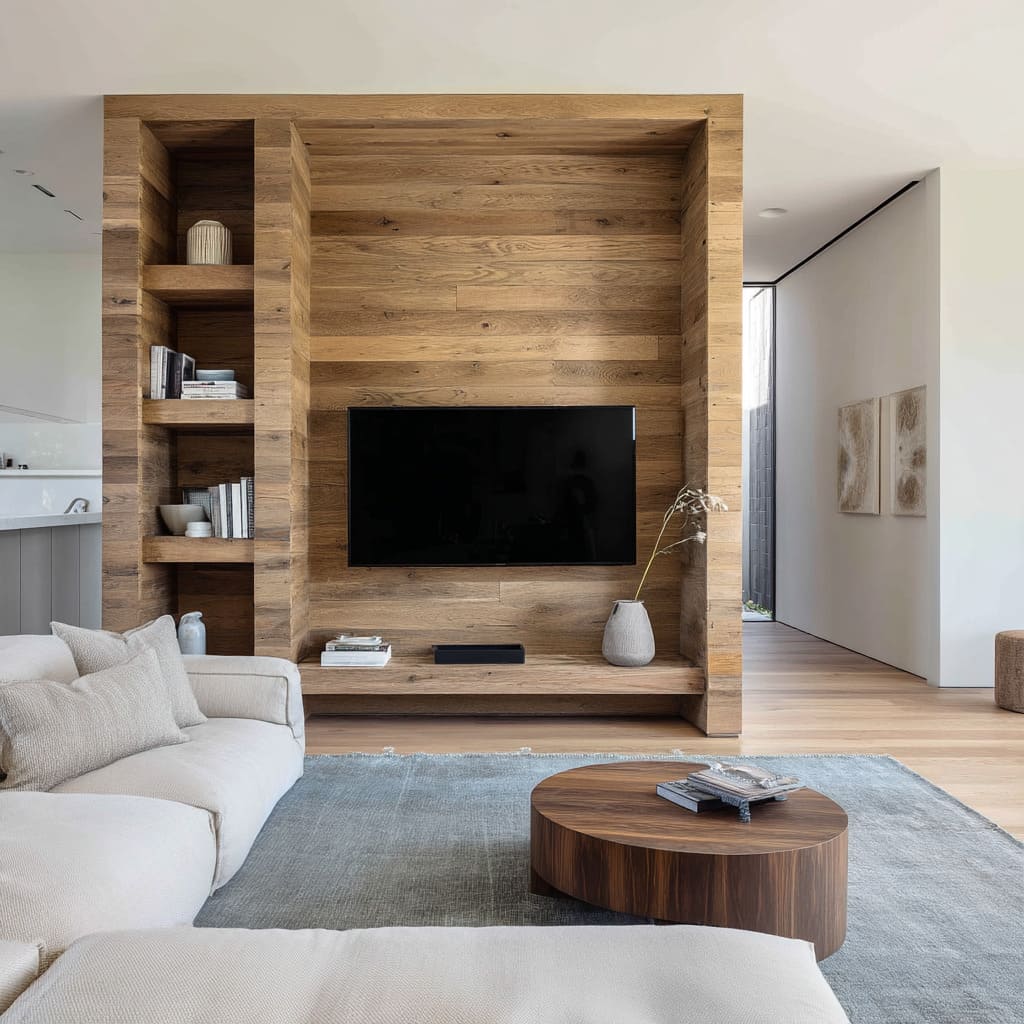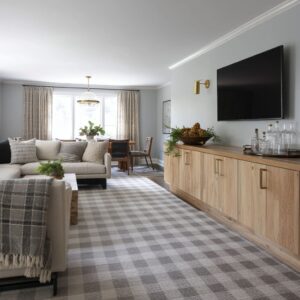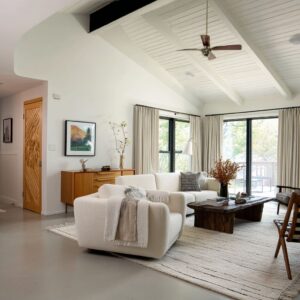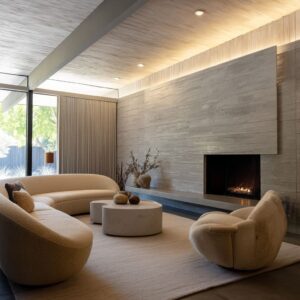TV walls in modern farmhouse interiors have moved far beyond the days of bulky cabinets and wall-mounted screens with no plan around them. What once served a single function now shapes the entire room.
Across today’s thoughtfully designed living spaces, these walls are treated like architectural features—built-in, textural, and visually balanced.
This article explores how farmhouse media walls are being rethought with careful materials, measured light, and proportion-aware layouts. From subtle framing tricks that downplay the screen’s presence to material combinations that add weight without heaviness, every decision supports a wider goal: making the television feel like it belongs in the space, not simply placed into it.
What ties these modern examples together is a sense of intention. The grain direction, finish tones, lighting choices, and shelf placement each carry quiet influence.
In some homes, the TV sits framed inside warm oak slats or a limestone arch. In others, it’s almost hidden beside a wide fireplace or tucked behind sliding panels made from reclaimed wood.
These choices shape how the room works—and how it feels. From coastal homes to suburban settings, modern farmhouse tv walls now reflect a layered blend of comfort and control.
Whether subtle or standout, these designs turn living rooms into lived-in spaces, where screens are present but never dominate.
Architectural Integration Over Add-On Thinking
In today’s high-end living rooms, the TV wall has shifted from being an afterthought to a built-in architectural structure. It no longer feels like a device mounted on an empty plane but rather a natural part of the room’s construction.
Whether it’s a boxed volume wrapped in wood, a stone-block elevation, or a continuous paneled surface, each version turns the screen into a feature that fits—not floats.
These types of installations borrow techniques from actual building details. Flush seams, boxed niches, and layered panel reveals are doing more than adding dimension—they quietly handle the changes wood goes through with humidity and heat.
Those recessed lines aren’t only visual accents; they allow expansion and contraction without paint cracking, and at the same time, they give a crisp edge that sharpens the overall profile. What seems clean and minimal on the surface often relies on construction precision hidden behind it.
It’s this approach—treating the media wall as a form of cabinetry architecture—that separates today’s modern farmhouse tv wall ideas from the generic builds of years past. The screen becomes part of the layout instead of just hanging there, surrounded by wires or bulky furniture.
Vertical vs. Horizontal Grain as Main Cue
The direction of wood grain on a wall might seem like a detail easy to overlook, but it plays a major role in how a space feels. Across many rooms, vertical slats and paneling quietly lift the ceiling visually.
This is especially helpful in tighter suburban homes, where the extra height they imply can make a big difference in the overall sense of space. The visual stretch draws the eye upward without needing any elaborate structures.
On the flip side, horizontal cladding works like a calm backdrop, often chosen for wider living rooms or open-plan spaces where horizontal movement already defines the layout. It stabilizes the room’s visual weight and stretches the view laterally, which can help offset tall ceilings or narrow walls.
In double-height spaces, horizontal grain calms the vertical pull and gives the eye a place to rest.
The choice of width between boards is where tone and style come in. Slim battens create a modern rhythm, especially when paired with flat fronts or hidden seams.
In contrast, wider boards or V-grooves lean into a soft nod to old barn interiors without slipping into nostalgia. One subtle trick in many examples is using slim vertical boards across the main face, then adding thicker edges to shelves or cabinets nearby.
It keeps the wall from feeling thin or flimsy, even when the lines are fine. This kind of proportion control is what defines a thoughtful modern farmhouse wall unit—not overly ornate, but still layered and grounded.
Material Authenticity Without Rustic Weight
Today’s modern farmhouse tv wall setups lean heavily on material honesty—but without falling into the trap of heavy-handed rusticity. Oak, plaster, brick, and limestone are still used, but they appear pared back, stripped of visual bulk, and styled with care.
Walls finished in low-sheen limewash handle light with subtlety. The texture softens reflections and mutes sharp contrasts.
It also conveniently blurs fingerprints and screen edges when the TV is off, making the setup feel more like part of the room and less like a tech feature.
Whitewashed brick shows up often, but not in its rawest form. It’s given a fine coat of lime-based slurry, just enough to even out the texture while letting the lines stay sharp.
Unlike heavy sealants, this finish breathes with the material—so it helps prevent moisture buildup and keeps the wall looking dry and fresh in varied climates.
Reclaimed timber is often cut only on the back side to allow mounting, while the front is left visibly marked by saw blades and time. These imperfections are no longer treated as flaws—they’re part of the atmosphere.
Grazing light catches the unevenness, making the surface change character throughout the day without needing extra items hung in front of it. It’s this careful tension—between raw and controlled—that lets materials feel alive without weighing the room down.
Light as Surface Modifier, Not Decoration
Across many farmhouse tv room ideas, light isn’t used to grab attention—it’s used to shift the way each surface behaves. Light draws out texture, gives shape to flat walls, and sets the mood quietly but with precision.
Integrated coves run along the upper edges of plank walls, sending light downward across the grain. This type of soft glow exaggerates subtle textures while avoiding harsh lines or bright spots.
It makes the wall feel three-dimensional even without visible fixtures.
Linen sconces placed closer to seat height add a different kind of softness. This choice reduces the contrast between the screen and surrounding surfaces, which becomes especially helpful when watching at night.
The low glow wraps the space gently, instead of casting glare across the room. Brass picture lights, often mounted above built-in shelves, create a faint visual lift around neutral-toned objects.
Instead of spotlighting, they add a warm outline—giving even plain ceramics or paperbacks a quiet presence.
An insider detail: the lighting color temperature is rarely random. Warm LEDs between 2700K and 3000K are often used in combination with off-white or creamy paints.
This pairing keeps the wall balanced in photos—especially important for listings or portfolio shoots. Bright daylight LEDs, by contrast, would flatten wood finishes and bring out cool tones in ways that clash with natural materials.
These lighting choices aren’t about layering light sources—they’re about shaping how the surfaces feel at different times of day. Controlled, calm, and meant to serve the materials.
Camouflage, Contrast, and Off-Center Placement
There’s no single way to deal with a big black screen in a thoughtfully crafted space, so several techniques have emerged to work around it with visual ease. In some homes, the screen is framed—surrounded by architectural features like grid-style panels or even a limestone arch.
These additions shift the TV from a floating rectangle into something integrated and expected. Other rooms hide the screen entirely.
A sliding barn door, finished in reclaimed wood, moves across the wall when the screen isn’t in use. It’s more than a cover—it brings tactile grain and character to the space, even when closed.
Some setups distract instead, making the screen intentionally off-center. Mounting it beside a large fireplace or wrapping it in texture-heavy materials shifts attention elsewhere.
The focus lands on wood, stone, or lighting—not the device.
Another subtle tactic makes a quiet difference: matte-screen TVs paired with muted wall colors like sage or soft taupe help reduce reflections from windows. Especially in daylight, glossy screens tend to act like mirrors—exposing every window and even the person taking the photo.
Using soft finishes with light-absorbing colors gives the wall a clean, camera-ready look. These farmhouse tv wall ideas often blend functional placement with visual balance, making the TV feel like part of a bigger plan.
Furniture and Storage Morphology
Beneath the screen, storage doesn’t just store—it supports the full composition. Across many modern farmhouse tv room designs, floating consoles are favored.
They offer visual space underneath, let robot vacuums pass without trouble, and keep the room feeling light. Textures matter.
Ribbed drawer fronts repeat the rhythm of wall slats, making the storage disappear into the structure. This consistency keeps the eye from stopping at the edge of each cabinet.
Cubbies have become a feature too—not just as open shelves, but as basket-ready compartments. The woven baskets are more than decorative.
They reduce speaker rattle, hold remote gear, and break up solid lines with softness.
Push-latch drawers without handles maintain a flat, quiet appearance. Designers often avoid recessed pulls here because even small indents would cast micro-shadows beneath integrated lighting strips.
Every detail like this helps the wall keep its clean flow. It’s this coordination of lines, textures, and materials that turns simple cabinetry into part of the overall structure—not just furniture against it.
Color as Mood Not Accent
Across many of today’s rooms, color does not shout—it shapes the atmosphere quietly, serving as a backdrop that influences every finish layered on top. In modern farmhouse tv room ideas, the palette is often treated as a base material rather than an accessory.
Soft whites and creamy off-tones work well with daylight and wide-angle photography. These colors don’t wash out detail—they give it room to breathe.
Unlike pure white, they hold warmth without flattening other textures in the room.
Sage greens and pale blush tones bring a faint floral quality, like clipped stems or pressed petals. These muted shades pair especially well with light oak and aged brass, where the contrast stays gentle but textured.
They give a nod to vintage garden tones without drifting into pastel. Deeper slate shades go in another direction.
When used wall-to-wall, they create a setting that wraps around the room. This move turns all the wood detailing—fluting, shelving, mantels—into shapes and shadows.
With this dark backdrop, pale furniture and soft rugs carry more presence, without the need for bright-colored art.
Earth tones like terracotta or clay-brown usually stay in the background. They appear in a vessel, a textile, or a single chair—but rarely as a full wall or cabinet.
This keeps the setting flexible through seasons and avoids locking the room into a theme. It’s color used more like texture—something that shifts subtly as light moves through the day.
Emerging Directions
Some changes are more subtle than they appear at first glance, and others are slowly becoming standard in higher-end homes. One standout shift is the return of stone arches framing the screen.
These structures replace heavy wood mantels or beams, bringing in a cooler material that doesn’t shift or split with climate changes. They hold shape and color through seasons and add softness without needing to be rustic.
There’s also more use of single-tone wall units, often finished in mid-tone greens, mushroom grey, or muted blue-greys. These walls avoid visual clutter and give built-ins a sculptural calm, letting the objects placed inside feel deliberate without extra styling.
Built-in seating is starting to merge with media walls, too. Benches under screens or around shelving now include soft cushions, hidden compartments, and small touches like wireless charging spots or low headphone drawers.
It makes the entire wall feel like a living space, not a tech zone. Lighting is getting thinner and smarter.
Behind wall planks, LED glow lines are routed during construction—so the light doesn’t sit on top, but bleeds out quietly from within. These strips often fade automatically once the TV is powered on, minimizing screen glare.
And symmetry? It’s fading a bit.
Screens are being shifted left or right to make room for artwork or to balance fireplace forms. This use of asymmetry makes the wall feel hand-built rather than measured from a showroom.
All together, these trends don’t reinvent the style—they adjust it to fit how people actually live. The strongest rooms combine architectural moves with honest textures and quiet utility, creating modern spaces that stay grounded without relying on nostalgia.
